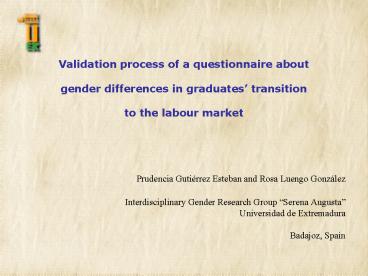Validation process of a questionnaire about
1 / 22
Title: Validation process of a questionnaire about
1
- Validation process of a questionnaire about
- gender differences in graduates transition
- to the labour market
- Prudencia Gutiérrez Esteban and Rosa Luengo
González - Interdisciplinary Gender Research Group Serena
Augusta - Universidad de Extremadura
- Badajoz, Spain
2
Outline
- Introduction
- Justification
- Research question
- Aims
- Research design
- Data analysis
- Discussion of results
- Conclusions and comments
- Definitive questionnaire proposal
3
Literature review
4
1. Justification
UNIVERSITY
SOCIETY
Concern about employment Quality of university
training
5
Scientific measures in research tools
6
2. Research question
Teachers training in gender equality
Facultad de Educación
7
Gender perspective
8
Questionnaire as research tool
- Questionnaire by post
- Making a questionnaire
- Implementing the questionnaire
- Combination of several methods
9
Labour transition Psychopedagogy degree
- Subjects in Psychopedagogy degree at University
of Extremadura - Psychopedagogy students
- Surveys on transition to labour market from
higher education - Difficulties in the access to labour market
- Functions and tasks
- Satisfaction with studies
10
Research validity
Internal validity
- Campbell and Stanley (1963)
External validity
Statistical conclusion validity
Construct validity
11
Scientific rigor in tools for researching
- Instruments for measuring reliability, validity
and objectivity - The tool for research should fit the population
of study - Lack of validity due to an erroneous
questionnaire design or problems with random
sample - Sampling methods
12
3. Aims
- To carry out the validation of a questionnaire to
understand Psychopedagogy graduates transition
process from a gender perspective - DESIGN A RELIABLE AND VALID TOOL FOR RESEARCH
- OBTAIN AND ANALYZE DATA FROM VALIDATION PROCESS
- ELABORATE CONCLUSIONS AND TAKE DECISIONS
- REDACTING THE DEFINITIVE QUESTIONNAIRE FOR A
SUBSEQUENT IMPLEMENTATION OF QUESTIONNAIRE
13
4. Research design
- Educational research model
- Research stages
- Method of making and validating a questionnaire
- Participants in our study
14
Elaborating the questionnaire
15
Research stages
16
Variables
- Sex
- Year completing university degree
- Satisfaction with university degree
- Professional routes
- Job satisfaction
- Equality of opportunities
- Training and subjects of study
17
Theoretical dimensions
- Personal and academic data
- Training
- Satisfaction with university studies
- Employment data
- Satisfaction at work
- Opinions about Equality of Opportunities
18
Methodology
- We established a distribution of specialists
subgroups from several fields of study (see Fig.
1 and 2). Some of them from Spanish universities
(see Fig. 3). - The questionnaire assessed by each person of
expert subgroups according to the following
variables Adequacy (Yes/No) and Assessment
(0-10). - In addition, they could refill marks (text) for
making suggestions or changes for each item and
the whole questionnaire - The answers collection sheet was composed of
dichotomous questions for Adequacy and one
choice question for Assessment. Also open
questions for comments and suggestions (Fig. 4)
19
A. Personal dataB. Academic
dataC. University trainingD. Employment data.
AntecedentsE. Seeking jobF. First jobG.
Current job or last jobH. Level of satisfaction
at workI. Equal opportunities
First version of the questionnaire
20
Questionnaire pilot study
- Presentation and information about the
questionnaire - Instructions for completing it
- Personal data
- University training
- Complementary training
- Employment data
- Seeking a job
- First job
- Current job or last job
21
Method of validating the questionnaire
Implementing the questionnaire in a pilot sample
Assessment by groups of experts
22
(No Transcript)
23
Participants
Fig. 1 and 2 Groups of experts distribution and
Pilot sample by sex
24
Fig. 3 Expert people distribution by
universities subgroup
25
5. DATA ANALYSIS
Managing data
- Data base design
- Question Mark (Gutiérrez et. al., 2005)
- Statistical analysis of data
- Data base with experts suggestions
- Data base with pilot samples incidences
26
Fig. 4 An expert persons answers in QM file
27
Fig. 5 Hit rates report in QM
28
6. DISCUSSION OF RESULTS
- In general, items have a positive assessment
- On average variables shows values of 1 (Yes)
for Adequacy and of 8 (from 0 to 10) for
Assessment - Better punctuactions in sections of Personal
data and Seeking a job - Lowest punctuaction in sections Current or last
job
29
6. DISCUSSION OF RESULTS
- More number of missing values in
- Section Equality of Opportunities
- Items b (20b, 26b,29b,44b,58b and 67b)
- Variable assessment
- Content analysis for experts suggestions and
incidences in pilot sample - Changes and definitive questionnaire proposal
30
7. CONCLUSIONS
- After this experience we can say the
questionnaire is a valid tool for research - Statistical data enables collection of numeric
data which guarantee the methodology used and the
codification of experts assessment.
31
7. CONCLUSIONS
- Suggestions made by two groups allow us to
declare our questionnaire is complete, meeting
the aims of the study - It is a questionnaire with an acceptable response
rate
32
Comments
- Delay on questionnaires submission
- Psychopedagogy degree has been recently created
- Moreover it is need to analyze reliability of
questionnaire - and using other research methods (mixed
methodology) - Innovative aspect questionnaire includes gender
perspective and also the methods we used for
validating the questionnaire
33
8. DEFINITIVE QUESTIONNAIRE PROPOSAL
- Instructions for completing questionnaire
- Personal data
- Information about university degree
- Complementary training
- Employment data
- Seeking a job
- First job
- Current or last job
- Comments or suggestions
34
- Critical comments or questions
- will be very welcome
- Thank you
- pruden_at_unex.es rosaluen_at_unex.es































